Coffee filter sizes play a crucial role in brewing, affecting flavor and quality. This guide explores various shapes, materials, and sizes to help you choose the perfect filter for your needs.
Why Coffee Filter Size Matters
Coffee filter size significantly impacts brewing quality and flavor. The wrong size can lead to overflow, weak extraction, or over-extraction, affecting the taste. Proper fit ensures even extraction, preventing grounds in the coffee and mess. Filter size aligns with brewer capacity, influencing the balance of flavors and oils. Choosing the right size is essential for optimal brewing performance and a satisfying cup of coffee.
Overview of Coffee Filter Types and Shapes
Coffee filters come in various types and shapes, including cone, basket, and disc filters. Cone filters are ideal for pour-over and single-serve brewers, while basket filters are standard for drip coffee makers. Disc filters are versatile for different brewing methods. Each shape and type is designed for specific brewers, ensuring optimal extraction and flavor. Understanding these differences helps in selecting the right filter for your brewing setup and preferences.
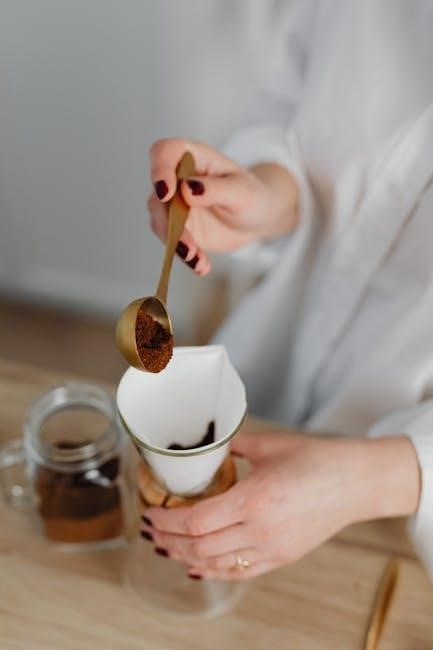
Coffee Filter Shapes and Their Uses
Coffee filters come in cone, basket, and disc shapes, each designed for specific brewing methods. Cone filters suit pour-over and single-serve brewers, while basket filters are ideal for drip coffee makers. Disc filters offer versatility across various brewing techniques, ensuring optimal extraction and flavor tailored to your preferred brewing setup.
Cone Filters: Shape, Capacity, and Brewers
Cone filters are designed for pour-over and single-serve coffee makers, offering precise extraction. Their tapered shape allows for even water flow and optimal coffee grounds saturation. Available in sizes like Size 1 (single cup) and Size 4 (larger batches), cone filters cater to various brewing needs. Proper sizing ensures balanced flavor and prevents overflow. Regular cleaning and replacing are essential for maintaining brew quality and preventing residue buildup.
Basket Filters: Standard for Drip Coffee Makers
Basket filters are the standard for drip coffee makers, designed for convenience and consistency. Available in sizes like Size 6 for 10-cup brewers, they feature a flat-bottom shape for even extraction. Made from bleached or unbleached paper, these filters are disposable and easy to use. Proper sizing prevents overflow and ensures balanced flavor. Always align the filter with your machine’s guidelines for optimal performance and a clean brew.
Disc Filters: Compatibility and Brewing Methods
Disc filters are designed for specific brewing methods and machines, offering compatibility with urn-style brewers and catering setups. Common sizes include 90/250 mm and 110/250 mm, ideal for large batches. These filters ensure even extraction and are often used in commercial or high-volume settings. Their flat design allows for consistent water flow, making them a practical choice for certain drip and pour-over systems. They cater to unique brewing needs, especially in catering environments.
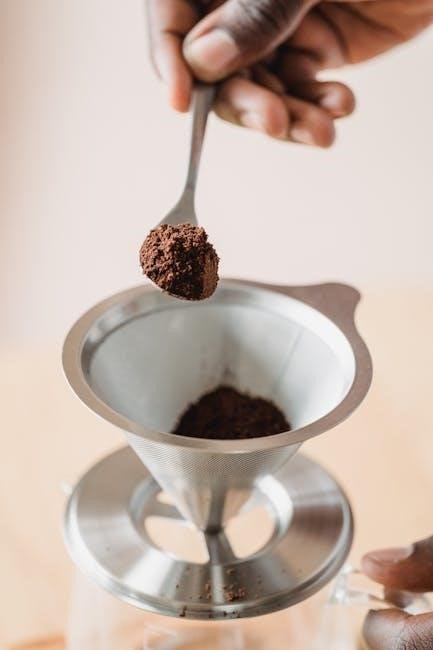
Coffee Filter Materials and Their Impact
Coffee filters come in paper, metal, and cloth materials, each influencing flavor and convenience. Paper filters offer cleanliness, metal retain oils for richer taste, and cloth provides reusability and texture.
Paper Filters: Cleanliness and Convenience
Paper filters are renowned for their ability to deliver a clean and balanced cup of coffee by absorbing impurities and oils. They are ideal for pour-over and drip brewing methods, offering convenience and consistency. However, they generate waste and require frequent replacement, making them less eco-friendly compared to reusable options. Despite this, paper filters remain a popular choice for their simplicity and ability to prevent old coffee residues from affecting flavor.
Metal Filters: Oil Retention and Flavor
Metal filters are designed to retain the coffee’s natural oils, resulting in a richer and more full-bodied flavor compared to paper filters. They allow the coffee grounds to steep more thoroughly, enhancing the texture and complexity of the brew. While they are reusable and eco-friendly, metal filters require regular cleaning to prevent residue buildup, ensuring optimal flavor in every cup.
Cloth Filters: Reusability and Texture
Cloth filters are a popular choice for their reusability and unique texture impact. They allow coffee’s natural oils and sediments to pass through, creating a heavier body and coarser texture. Cloth filters are eco-friendly but require thorough rinsing before use to prevent off-flavors. Their durability makes them a long-term investment, though they demand consistent maintenance to ensure optimal brewing results and flavor consistency.
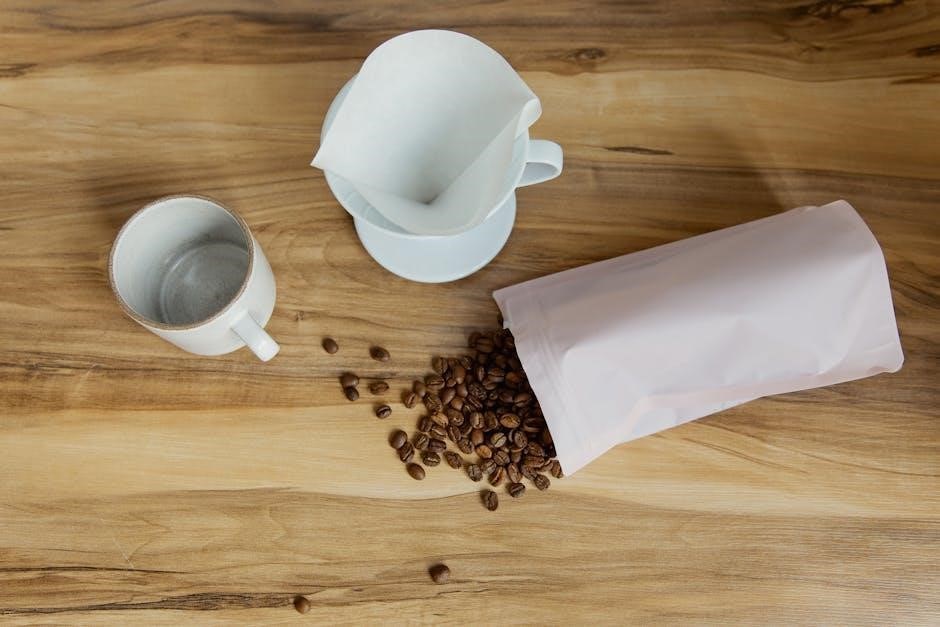
Understanding Coffee Filter Sizes
Coffee filter sizes significantly impact brewing quality and flavor. From small cone filters to large basket styles, each size is designed for specific brewers and batch capacities, ensuring optimal extraction and flow.
Standard Coffee Filter Sizes: A Comprehensive Guide
Standard coffee filter sizes range from Size 1 to Size 6, each designed for specific brewers and batch capacities. Size 1 fits single-serve makers, while Size 2 suits 1-6 cup brewers. Size 4 is ideal for 8-12 cup machines, and Size 6 accommodates 10-cup makers; Catering filters, like 90/250 mm and 110/250 mm, are used for larger batches. Understanding these standards ensures compatibility and optimal brewing performance, helping you select the perfect filter for your coffee maker.
Coffee Filter Size Chart: Capacity and Brewer Match
A standard coffee filter size chart shows that Size 1 fits single-serve makers, Size 2 suits 1-6 cup brewers, Size 4 works for 8-12 cup machines, and Size 6 fits 10-cup makers. Catering filters, like 90/250 mm and 110/250 mm, are designed for larger batches. Matching the right filter size to your brewer ensures proper fit, prevents overflow, and optimizes extraction for a perfect cup of coffee every time.
How Filter Size Affects Brewing: Extraction and Flow Rate
Filter size directly impacts extraction and flow rate during brewing. Smaller filters can lead to over-extraction if not managed properly, while larger ones allow for even saturation. Proper fit ensures optimal water flow, preventing channeling or overflow. The right size balances extraction, ensuring a flavorful brew without under- or over-extraction, making it essential for achieving the perfect cup of coffee consistently.

Choosing the Right Filter for Your Brewer
Selecting the right filter ensures optimal brewing performance. Measure your coffee maker, match filter size to capacity, and consider brewing method for the best flavor and quality.
Measuring Your Coffee Maker for the Perfect Fit
Accurate measurement ensures your filter fits seamlessly. Measure the bottom width and side wall height of your coffee maker. Common sizes include 3.25 inches for the bottom and 2.25 inches for the sides. Use a ruler to determine these dimensions precisely. Check your user manual for specific size recommendations. Proper fit prevents overflow and ensures even extraction. This step is crucial for optimal brewing performance and flavor consistency.
Matching Filter Size to Brewer Capacity
Filter size must align with your brewer’s capacity for optimal performance. A size 2 filter suits 1-6 cup makers, while size 4 fits 8-12 cup brewers. Size 6 is ideal for 10-cup machines. Proper sizing prevents overflow and ensures even extraction. Measure your brewer to match the filter’s bottom width and height. This ensures a perfect fit, enhancing flavor and brewing efficiency. Correct sizing is key to achieving the best results.
Adapting Filter Sizes for Different Brewing Methods
Filter sizes vary to suit different brewing techniques. Pour-over methods often use cone-shaped filters in sizes 1-4, while drip makers rely on basket filters in sizes 2-6. Single-serve devices may require smaller, specialized filters. Adjusting filter size ensures proper fit and extraction. For example, a size 2 filter works well for 1-6 cup brewers, while size 4 suits 8-12 cup machines. Proper sizing enhances flavor and prevents overflow, ensuring optimal brewing results.
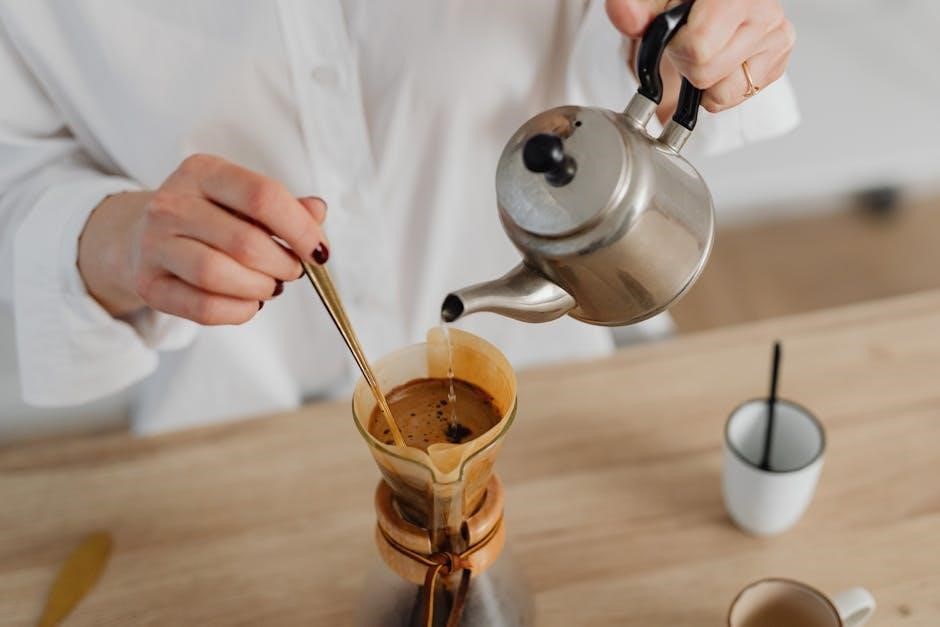
Coffee Filter Maintenance and Care
Regular cleaning prevents old coffee oils from affecting flavor. Replace paper filters every 1-2 months and store reusable ones dry to avoid mold.
Cleaning and Reusing Filters: Best Practices
Regular cleaning ensures optimal flavor and prevents residue buildup. For metal and cloth filters, rinse with hot water and mild detergent after each use. Dry thoroughly to avoid mold. Paper filters should be discarded, but reusable ones can be cleaned gently to maintain hygiene. Proper care extends filter lifespan and prevents off-flavors, ensuring a fresh brewing experience every time.
Replacing Filters: When and Why
Replace paper filters after each use to avoid residue buildup and off-flavors. For reusable metal or cloth filters, replace them every 1-2 years or when showing signs of wear. Regular replacement ensures optimal flavor and prevents bacterial growth. Neglecting to replace filters can lead to stale-tasting coffee and potential hygiene issues, making it essential to maintain your filters for a consistently great brew.
Preventing Off-Flavors: Proper Storage and Handling
Proper storage and handling of coffee filters are essential to prevent off-flavors. Store filters in a cool, dry place away from direct light and moisture to maintain freshness. Avoid exposure to strong-smelling foods, as filters can absorb odors. Handle filters gently to prevent tears, which can lead to uneven extraction. Always use the correct size for your brewer to avoid overflow and contamination, ensuring a clean and flavorful cup every time.
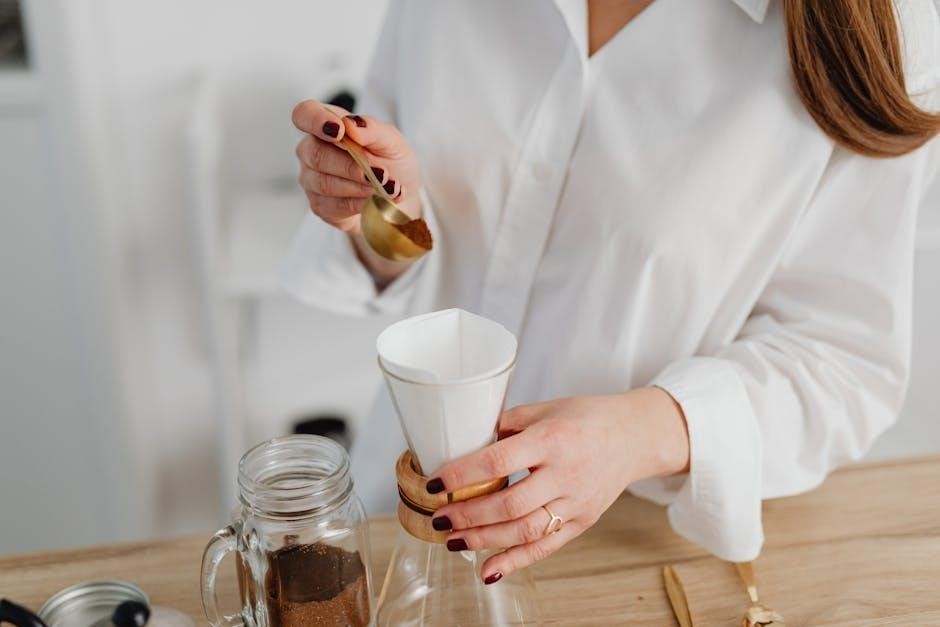
Sustainability and Cost Considerations
Sustainability and cost considerations involve choosing between reusable and paper filters, balancing eco-friendliness with convenience and expense, while reducing waste and saving money long-term.
Eco-Friendly Options: Reusable vs. Paper Filters
Eco-friendly options like reusable metal or cloth filters reduce waste and long-term costs, offering a sustainable alternative to paper filters. While paper filters are convenient, they generate regular waste. Reusable filters, though requiring maintenance, provide a greener choice for environmentally conscious coffee lovers, balancing convenience with sustainability for a more eco-responsible brewing experience.
Cost Analysis: Long-Term vs. Short-Term Expenses
Reusable filters, though more expensive upfront, offer long-term savings and reduce waste, making them a cost-effective choice over time. Paper filters, while affordable initially, lead to higher recurring costs and environmental impact. Balancing convenience and sustainability, reusable options like metal or cloth filters provide a practical investment for frequent coffee drinkers, lowering the cost per cup and minimizing waste over time.
Reducing Waste: Tips for Coffee Filter Usage
To minimize waste, opt for reusable metal or cloth filters, which can be cleaned and used repeatedly. Compost used paper filters and coffee grounds to reduce landfill contribution. Properly dispose of paper filters in recycling or compost bins. Choose biodegradable or unbleached options when paper filters are necessary. These practices help reduce environmental impact while maintaining a sustainable coffee routine.
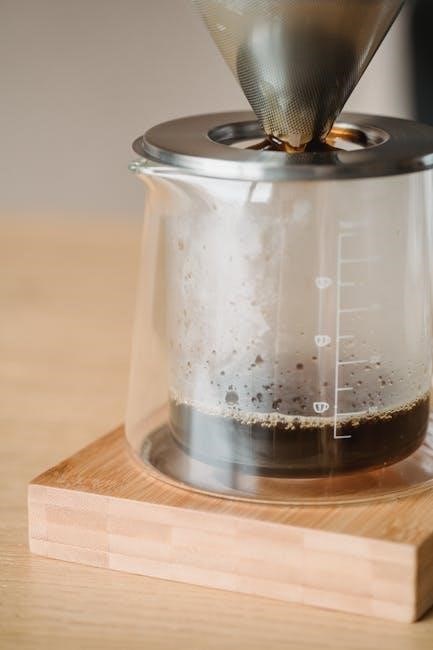
Popular Coffee Filter Brands and Recommendations
Top brands like Melitta and Chemex offer high-quality filters. Melitta’s paper filters are known for their durability, while Chemex’s glassware and filters ensure a clean, balanced brew.
Top Brands for Paper Filters
Leading brands like Melitta, Chemex, and Hario offer superior paper filters. Melitta’s filters are known for durability and consistent extraction, while Chemex’s thicker paper ensures a clean, balanced brew. Hario’s filters, designed for pour-over methods, provide precision and eco-friendly options. These brands are trusted by coffee enthusiasts for their quality and compatibility with various brewing techniques, ensuring optimal flavor and convenience for both home brewers and professionals.
Recommended Metal and Cloth Filter Brands
For metal filters, brands like Soma, Kone, and Able Brewing are highly regarded for their durability and ability to retain coffee oils, enhancing flavor. Cloth filters from Swoon and other GOTS-certified brands offer eco-friendly, reusable options with unique textures. These brands are favored by coffee enthusiasts for their quality, sustainability, and ability to deliver distinct brewing experiences, making them ideal choices for those seeking premium metal or cloth filters.
Specialized Filters for Unique Brewing Methods
Specialized filters cater to unique brewing methods, ensuring optimal extraction and flavor. For instance, catering filters are designed for large-capacity urns, while disc filters are ideal for espresso or moka pots. Brands like Melitta offer flat-bottom filters for specific drip brewers, and reusable options like cloth filters suit pour-over systems. These tailored solutions enhance brewing precision and adapt to diverse coffee-making techniques, providing the perfect fit for every method.
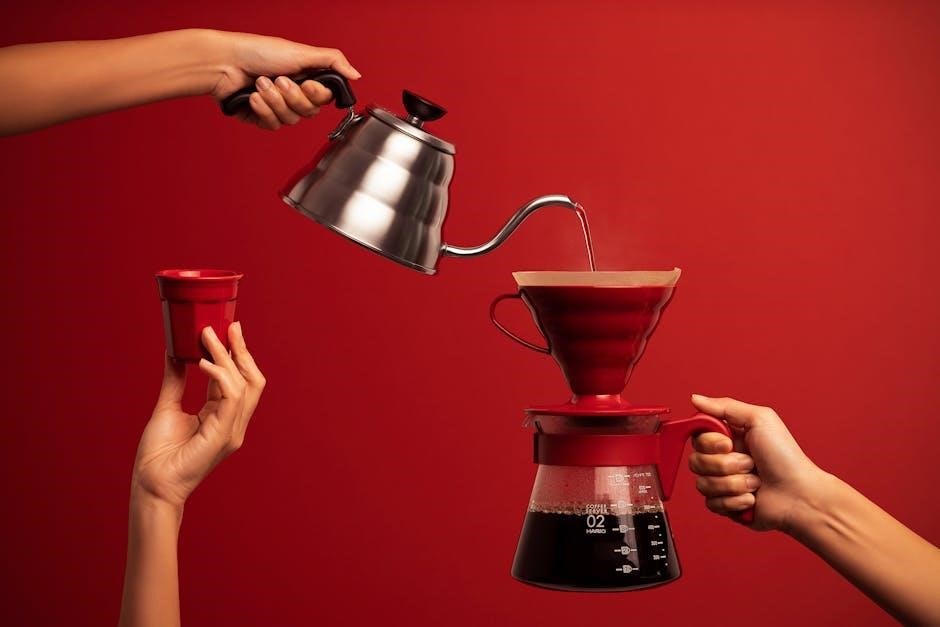
Troubleshooting Common Issues
Coffee ground overflow, weak brews, and poor fit are common issues tied to incorrect filter size. Address these by ensuring proper fit and capacity for your brewer.
Dealing with Coffee Ground Overflow
Coffee ground overflow often occurs when using a filter too small for the brewer or pouring water too quickly. To fix this, choose a filter that fits your brewer’s capacity and pour slowly. A smaller filter, like size 2 in a larger machine, requires careful pouring to avoid overflow. This prevents a messy cleanup and ensures even extraction for a better-tasting coffee.
Fixing Weak or Over-Extracted Coffee
Weak or over-extracted coffee often stems from improper filter size or brewing technique. A filter too large may allow grounds to under-extract, while a smaller filter can cause over-extraction. Adjusting the filter size to match your brewer’s capacity ensures balanced extraction. Additionally, monitoring grind size and water quantity helps achieve the perfect brew, preventing weak or bitter flavors and enhancing overall coffee quality.
Resolving Fit Issues with Your Brewer
Ensuring your coffee filter fits perfectly is essential for optimal brewing. Measure your brewer’s filter basket to select the correct size, as a mismatch can cause overflow or poor extraction. If a filter is slightly too large, trimming it to fit or using an adapter can resolve the issue. Always consult your brewer’s manual for size recommendations to achieve a seamless fit and prevent brewing inconsistencies.
Advanced Coffee Brewing Techniques
Mastering advanced brewing techniques requires precision. The right coffee filter size ensures optimal extraction and flow rate, enhancing methods like pour-over and bloom water techniques for superior flavor.
Using Filter Size for Precision Brewing
Using the correct filter size ensures precise extraction and flow rate, crucial for methods like pour-over and bloom techniques. A size 2 filter suits 1-6 cup brewers, while size 4 fits 8-12 cup machines. Proper fit prevents overflow and ensures even saturation, avoiding under or over-extraction. Matching filter size to brewer capacity enhances flavor balance and consistency, making it a vital step in achieving a perfect cup of coffee every time.
Optimizing Bloom Water and Pouring Techniques
Optimizing bloom water and pouring techniques enhances extraction and flavor. Use 20-30 grams of water per bloom, depending on coffee quantity. Pour in a circular motion to saturate grounds evenly. The right filter size ensures proper water flow, preventing under or over-extraction. For smaller batches, slower pours maintain control, while larger batches may require steady, consistent flow. This balance achieves a perfectly balanced and flavorful brew every time.
Enhancing Flavor with the Right Filter
The right filter significantly enhances coffee flavor by controlling oil retention and extraction. Paper filters absorb oils, yielding a cleaner taste, while metal and cloth filters preserve oils for a fuller-bodied brew. Proper filter size ensures even extraction, preventing under or over-extraction. Experimenting with materials and sizes can tailor your coffee’s profile, balancing acidity and texture for a more satisfying cup.
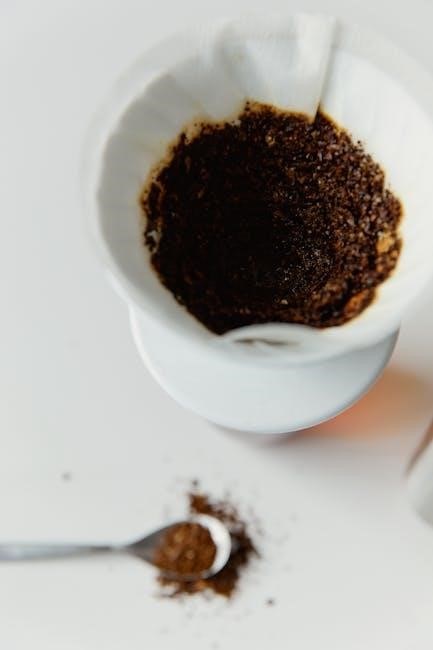
Frequently Asked Questions
This section addresses common inquiries about coffee filter sizes, materials, and troubleshooting, providing clarity for enthusiasts seeking to optimize their brewing experience with the right filters.
Common Questions About Coffee Filter Sizes
What size filter do I need? How does material affect flavor? Can I use a smaller filter in a larger brewer? These questions are common among coffee enthusiasts. Filter size impacts extraction and flow rate, while materials like paper, metal, or cloth influence flavor and convenience. Measuring your brewer and matching it to the correct filter size ensures optimal performance. Understanding these basics helps you brew consistently delicious coffee every time.
Addressing Misconceptions About Filter Materials
Many believe paper filters strip coffee of its natural oils, but they actually prevent bitterness. Metal filters are often thought to be difficult to clean, yet they’re durable and easy to maintain. Cloth filters are sometimes dismissed as old-fashioned, but they offer a unique texture and eco-friendly reusability. Each material has its benefits, and choosing the right one depends on your taste preferences and brewing goals.
Expert Tips for Coffee Filter Selection
- Measure your brewer to ensure a perfect fit, preventing overflow and uneven extraction.
- Match filter size to your coffee maker’s capacity for optimal performance.
- Choose materials based on flavor preferences: paper for cleanliness, metal for oil retention, or cloth for texture.
- Experiment with different filters to find the one that enhances your coffee’s unique characteristics.
- Regularly clean and maintain reusable filters to avoid off-flavors and extend lifespan.
Understanding coffee filter sizes is key to enhancing your brewing experience. Experiment with shapes, materials, and sizes to find your perfect match for better flavor and satisfaction.
Final Thoughts on Coffee Filter Sizes
Coffee filter sizes significantly impact extraction, flow rate, and overall flavor. Choosing the right size ensures proper fit, preventing overflow and under-extraction. Experiment with shapes and materials to tailor your brew. Reusable options offer sustainability, while paper filters provide convenience. Understanding filter size enhances brewing precision, allowing you to optimize your setup for the perfect cup. Invest time in selecting the ideal filter to elevate your coffee experience consistently.
Encouragement to Experiment and Explore
Embark on a journey to discover your ideal brew by experimenting with different filter sizes, shapes, and materials. Try various coffee-to-water ratios and brewing techniques to refine your flavor preferences. Attempting new methods, like pour-over or French press, can reveal unique textures and tastes. Keep exploring—every adjustment brings you closer to your perfect cup. Enjoy the process of learning and savor the joy of crafting your ultimate coffee experience.
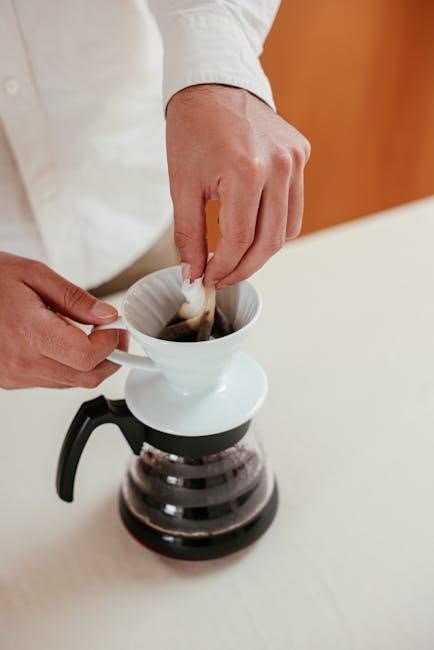


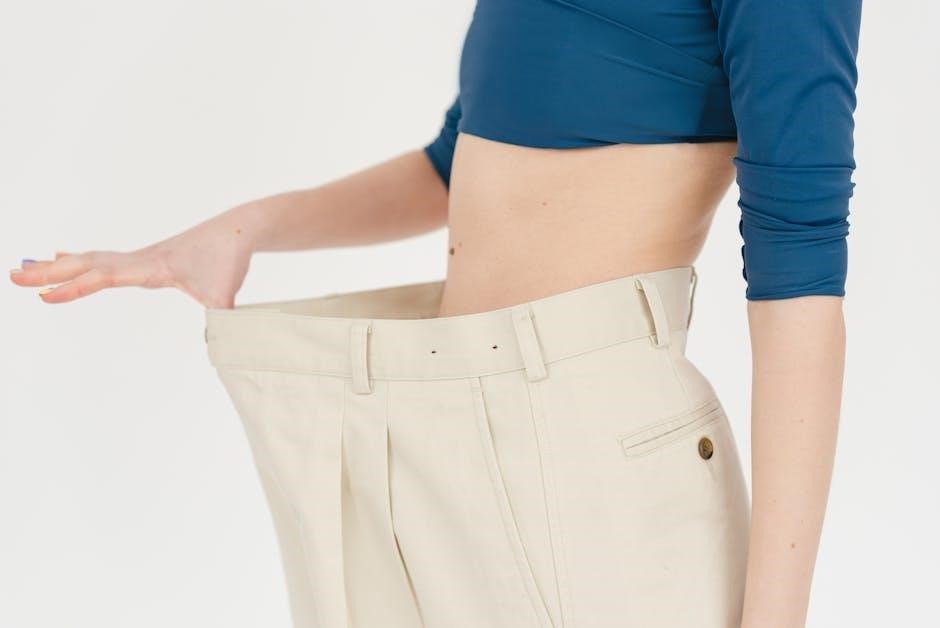
Leave a Reply
You must be logged in to post a comment.